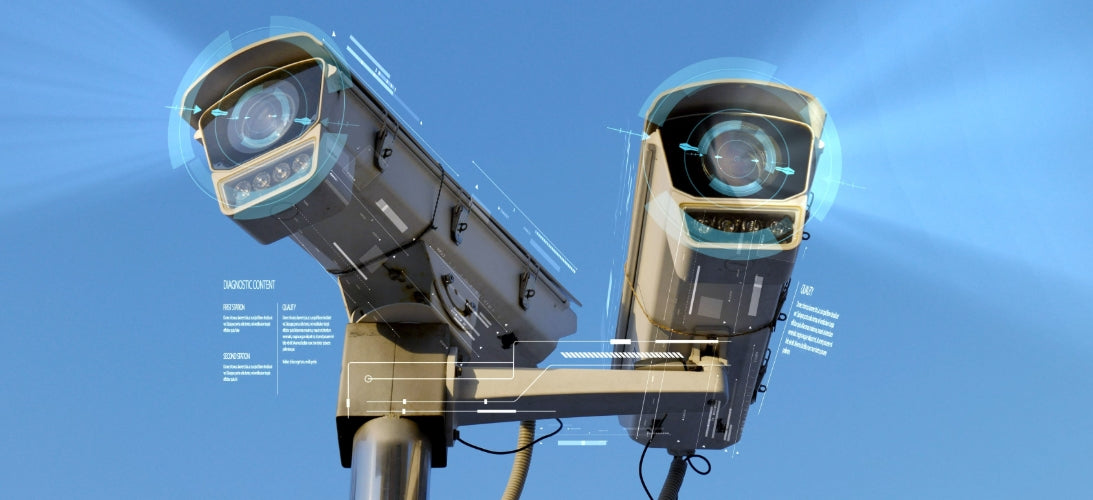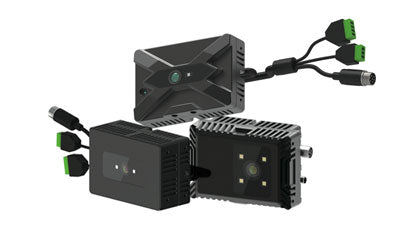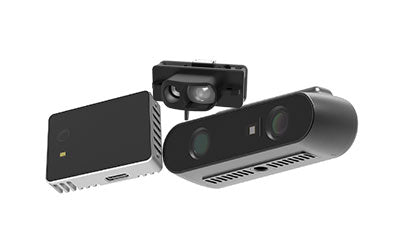Invisible Guardian: TOF Enhancing Intelligent Surveillance Security

In the accelerating era of digitalization and automation, security monitoring systems are undergoing a technological revolution. Traditional visible-light cameras, though widely deployed, have inherent limitations in privacy protection, low-light environments, and distance measurement. The rise of TOF (Time-of-Flight) technology offers a new path to create smarter, safer, and more 'invisible' monitoring systems.
This article deeply explores the advantages and application scenarios of TOF in intelligent surveillance, revealing how it accurately perceives spatial changes without invading privacy, becoming the 'invisible guardian' of security boundaries.
1. Limitations of Traditional Surveillance: Privacy Risks and Lighting Dependence
Current widely used surveillance cameras rely on visible light imaging, which, although clear, means:
-
High privacy exposure risk, especially in privacy-sensitive environments like homes, offices, or financial institutions;
-
Strong dependence on lighting conditions, with significant performance drop in nighttime or low-light, increasing lighting and maintenance costs;
-
Lack of depth information, making precise distance judgment between people/objects and cameras difficult, thus challenging accurate alerts or behavior analysis.
Traditional 2D imaging systems face a balance dilemma among intelligence, security, and user experience, where 3D TOF cameras (such as 【3D ToF camera】) offer breakthroughs.
What is a ToF camera used for?
A ToF camera measures the distance and depth between objects and the camera, widely applied in 3D modeling, spatial surveying, robot navigation, smart manufacturing, and security monitoring.
2. TOF: The 'Depth Perception Expert' in No-Light Environments
TOF (Time-of-Flight) cameras are active 3D imaging devices that emit modulated infrared light signals to the target area and precisely measure the time difference from emission to return, calculating the actual distance from each pixel to the camera. This process does not rely on visible light but uses infrared ranging technology to achieve millimeter-level high-precision spatial perception, working steadily even in low or complete darkness.
Core advantages of TOF technology include:
-
Non-imaging perception, ensuring privacy compliance
Unlike traditional RGB cameras, TOF devices capture depth point cloud data (depth maps), not image frames, thus do not record recognizable information like faces or clothing. The output reflects only spatial structure and object contours, fundamentally avoiding personal privacy invasion, and naturally complies with GDPR, CCPA, and other international privacy regulations. This makes TOF especially suitable for privacy-sensitive places such as financial institutions, medical facilities, and changing rooms. -
Active infrared sensing, immune to lighting changes
TOF systems use active light sources and do not depend on ambient natural light, providing stable, continuous depth perception in dark or backlit environments like night, tunnels, or warehouses. Compared to cameras relying on supplementary lighting or infrared filters, TOF simplifies lighting control and significantly reduces deployment and maintenance costs. -
Real-time 3D modeling and dynamic tracking
TOF cameras can output 3D coordinates continuously at high frame rates (typically 30fps or higher), enabling real-time 3D modeling and target tracking. In 【3D sensing】 and 【3D depth camera】 systems, TOF data serves as frontend input for dynamic behavior recognition, path prediction, intrusion detection, and other intelligent algorithms, helping build monitoring systems that “understand scenes.” -
Compact structure, low power consumption, strong adaptability
With the development of TOF chip integration and optical technology, TOF modules are now highly miniaturized, easily embedded in phones, smart locks, surveillance cameras, robot vision modules, etc. Their power consumption is far lower than traditional 3D structured light systems, suitable for low-power real-time perception scenarios in edge computing terminals and IoT smart nodes like smart homes, campuses, and industrial safety.
TOF not only shows high applicability in intelligent surveillance but also drives the integration of 【3D imaging technology】 and 【robot vision】. In fields like industrial automation, service robots, smart buildings, and intelligent transportation, TOF technology is gradually replacing traditional 2D imaging, achieving an upgrade from 'seeing' to 'understanding.' Its high precision, real-time capability, and privacy-friendliness make it widely regarded as one of the core sensors for next-generation intelligent perception systems.
3. Typical Application Scenarios: Comprehensive Protection from Homes to Smart Campuses
With the miniaturization, intelligence, and cost reduction of TOF (Time-of-Flight) technology, it is gradually becoming the core sensor for next-generation spatial perception and security protection systems. Whether in privacy-sensitive homes, high-security financial institutions, or complex and dynamic smart industrial parks, TOF demonstrates unique advantages and wide applicability.
Home Security Monitoring: Privacy-Friendly Intelligent Guardian
-
Non-contact intrusion and fall detection: TOF cameras judge human contours and posture changes through depth maps, accurately identifying intrusion or elderly falls without capturing recognizable images. Ideal for infant, elderly care, and sleep quality monitoring.
-
AGV home patrol and security linkage: Integrating TOF modules into AGV material handling robots allows autonomous home patrols to detect spatial anomalies (e.g., doors/windows opened abnormally, prolonged presence) and issue alerts via voice or smart terminals, creating a mobile intelligent security platform.
-
Smart home system linkage: TOF detects room occupancy and distribution of people, linking with smart lighting, curtains, air conditioning, etc., to realize energy-saving control like 'lights on when people come, off when they leave.'
Financial Institution Security: Dual Tool for Privacy and Order
-
Privacy-friendly real-time monitoring: In bank halls and ATM areas, traditional cameras risk leaking facial information. TOF systems collect only non-image depth data, achieving regional behavior monitoring while completely avoiding privacy risks.
-
Abnormal behavior detection and queue guidance: TOF cameras identify queue length, standing time, and action states, quickly detecting loitering or tailgating, assisting security personnel to intervene and improving service efficiency.
-
Space utilization optimization and heatmap analysis: Analyzing customer paths and dwell times to provide data for smart space layout and personnel scheduling.
Smart Campus and Industrial Scenarios: Building Real-Time Responsive Spatial Security
-
Core sensing module for AGV navigation systems: TOF cameras installed around Automated Guided Vehicles achieve centimeter-level obstacle detection and personnel identification, ensuring safe AGV operation in dense logistics environments, seamlessly integrating with 【AGV navigation methods】 algorithms.
-
RGB-D human tracking and behavior analysis: Combining TOF with RGB cameras to output RGB-D data streams in factories or warehouses for real-time personnel behavior capture, recognizing standing/walking/falling states, enabling operation supervision and safety modeling.
-
Dynamic obstacle avoidance in robot collaboration: Integrating TOF depth sensing on platforms like 【robot sander】 or welding robots for dynamic obstacle detection, distance maintenance, and autonomous shutdown, creating flexible safety zones for human-robot collaboration.
-
Campus boundary and area security: Deploying TOF monitoring arrays in factories, campuses, or exhibition halls to detect intrusions, boundary crossing, and generate spatial heatmaps, providing multi-dimensional, visual management support for security personnel.
Comprehensive Value and Future Outlook
With AI chip proliferation and edge computing platforms becoming widespread, TOF is evolving from a traditional 'auxiliary sensing tool' to an active intelligent recognition terminal. In the future, it will deeply integrate with voice recognition, visual AI, and IoT systems to achieve comprehensive perception and response under the premise of 'zero-image privacy invasion,' building a truly intelligent security ecosystem.
4. AI Integration: Intelligent Intrusion Detection and Behavior Recognition
With the rapid advancement of artificial intelligence technology, the high-precision 3D depth data provided by TOF cameras has become a key foundation for realizing intelligent spatial perception. Depth data not only captures the shape and position of objects but also reveals complex spatial structural information, greatly enriching the input features for AI algorithms. This enables intelligent monitoring systems to shift from passive video recording to active perception and intelligent decision-making.
1. Area Intrusion Detection: Accurate Identification of Abnormal Behavior
Based on 3D depth maps generated by TOF, combined with convolutional neural networks (CNN) and temporal models such as LSTM, it is possible to accurately detect behaviors such as unauthorized personnel crossing boundaries, illegal intrusion, and abnormal lingering within specific areas. The system can not only recognize whether an object has entered a restricted area but also determine the duration of personnel behavior and movement trajectories, automatically distinguishing between normal access and potential threats.
This depth-based detection algorithm avoids false alarms caused by lighting changes or complex backgrounds typical of traditional cameras, effectively improving the stability and reliability of security systems.
2. Behavior Recognition: Diverse Action Analysis and Early Warning
Through extraction of human skeletal keypoints and spatiotemporal dynamic analysis from depth maps, AI models can recognize various typical behavior patterns, such as falling, running, fighting, and loitering. Especially in elderly care, construction site safety, and public venue management, fall detection and abnormal behavior warning significantly reduce accident risks.
Depth information also supports 3D human pose modeling, which enhances the robustness of behavior recognition, allowing accurate determination of behavior states even under partial occlusion or complex backgrounds.
3. Multi-Target Tracking: Fine-Grained Movement Trajectory Management
By combining TOF’s spatial depth coordinates with temporal sequence information, AI systems can achieve continuous tracking of multiple targets. Using 3D coordinate points from depth data, the system precisely tracks objects’ position changes in space and constructs high-precision movement trajectories.
Integrated with autonomous navigation algorithms like 【SLAM robot navigation】, the system can not only predict the future paths of targets but also plan obstacle avoidance and collaboration strategies for robots or automated devices, achieving safe and efficient shared spatial use.
Core Advantages of TOF Depth Data + AI
-
Privacy Protection: TOF collects depth maps that are non-visual and do not contain facial or clothing details, complying with data protection regulations such as GDPR, making it suitable for deployment in privacy-sensitive areas.
-
Strong Environmental Adaptability: TOF is unaffected by lighting conditions, enabling AI algorithms to achieve stable recognition in night or backlit environments, thereby expanding the application boundaries of intelligent monitoring.
-
Improved Recognition Accuracy: 3D spatial information provides richer semantic features for AI models, significantly reducing false positives and missed detections especially in complex, crowded, or cluttered environments.
Typical Application Examples
-
Intelligent Building Security: Real-time alerts for abnormal intrusion and behavior in office buildings and residential areas to ensure personnel safety.
-
Smart Factory Monitoring: Automatic identification of whether workers wear safety equipment, fall risk, and violations, promoting Industry 4.0 safety production.
-
Public Safety Scenes: Intelligent detection of crowding, running, fighting, and other emergencies in subways, airports, malls, etc., assisting security personnel for timely response.
By deeply integrating depth data and AI algorithms, TOF technology is evolving from a simple sensing device into an intelligent perception terminal, driving monitoring systems toward proactive warning and intelligent decision-making.
5. Non-Imaging Advantages: The Future Trend of Privacy-Compliant Monitoring
With the tightening of global data protection regulations such as the EU’s GDPR, privacy security has become a core issue that intelligent monitoring cannot avoid. Due to its unique 'non-imaging' depth sensing characteristic, TOF technology naturally meets the requirements of privacy compliance and is becoming an inevitable choice for future intelligent monitoring system upgrades.
1. Naturally Privacy-Friendly: Completely Avoids Capturing Facial Images
Unlike traditional RGB cameras that capture detailed recognizable images, TOF cameras only collect depth information of scenes, generating textureless 3D point clouds or depth maps. This means:
-
Image data contains no facial or identity information and cannot be used to reconstruct the monitored person’s appearance, effectively preventing personal privacy infringement.
-
Monitoring systems can accurately identify human contours and dynamic behaviors without producing any sensitive visual information, fully complying with global privacy regulations like GDPR and CCPA (California Consumer Privacy Act).
2. Broader Deployment Scenarios: Breaking Through Traditional Monitoring Restrictions
Thanks to the inherent privacy protection advantages of TOF technology, it can be safely deployed in many sensitive areas difficult for traditional cameras, such as:
-
Public restrooms, changing room passages, and other highly privacy-sensitive spaces, ensuring safety while eliminating any privacy leak risks.
-
Hospitals, nursing homes, enabling real-time monitoring and alerting of falls and abnormal behaviors without infringing on patients’ privacy rights.
-
Government agencies, financial institutions, where monitoring compliance requirements are extremely strict, ensuring safety supervision does not violate laws and regulations.
This 'non-imaging' monitoring helps build a safer and more trustworthy social environment.
3. Multi-Level and Multi-Modal Perception: Complementing Traditional Image Monitoring
Combining TOF depth sensing with traditional RGB camera technology builds a multi-modal, multi-level intelligent perception system:
-
Traditional cameras capture rich, colorful detailed images useful for identity verification and video review.
-
TOF cameras provide real-time precise 3D spatial structure and dynamic behavior information, enhancing system understanding and responsiveness to environmental changes.
-
The fusion of both data types greatly improves anomaly detection accuracy and response speed, while reducing false alarms.
This cooperative sensing strategy is becoming a key path to improving the comprehensive performance of intelligent security systems.
4. Technology Evolution: DTOF and TDC Converters Enable Precise Ranging
Continuous upgrades in TOF technology enhance the performance of non-imaging monitoring, mainly reflected in:
-
DTOF (Direct Time-of-Flight) technology: Measures the direct flight time of light pulses to achieve millimeter-level distance detection accuracy, enhancing the precision and stability of depth data.
-
TDC Converter (Time-to-Digital Converter) integration and optimization significantly increase light signal processing speed and resolution, reducing system latency and noise interference.
-
These technological advances allow TOF systems not only to be highly precise but also to respond faster in real time, meeting demanding requirements for dynamic scene monitoring.
Based on TOF non-imaging depth sensing, intelligent monitoring becomes a win-win solution for privacy protection and security supervision. It breaks through the bottlenecks of traditional video monitoring in privacy compliance and, through technological upgrades and multi-modal fusion, promotes intelligent monitoring systems toward higher efficiency, precision, and humanization.
With increasingly stringent global regulations, the application scope of TOF non-imaging technology will continue to expand, helping to build a safe, trustworthy, and intelligent digital society.
Conclusion: TOF as the Next Technological Foundation for Intelligent Monitoring
From 'visible' to 'depth perception,' TOF technology is gradually disrupting the technical paradigm of traditional monitoring systems. With multiple advantages such as privacy protection, reduced lighting dependence, and improved detection accuracy, TOF cameras are becoming the core sensing devices of future intelligent monitoring.
In scenarios such as 【3D vision inspection】, 【3D SLAM】, and 【robotics camera system】, TOF will play a key role in more intelligent terminals and industrial equipment. With further development of 【semiconductors 2024】 and 【3D TOF camera】 technologies, TOF will be widely adopted across industries, becoming an invisible guardian integrating safety and intelligence.
Synexens Industrial Outdoor 4m TOF Sensor Depth 3D Camera Rangefinder_CS40p
After-sales Support:
Our professional technical team specializing in 3D camera ranging is ready to assist you at any time. Whether you encounter any issues with your TOF camera after purchase or need clarification on TOF technology, feel free to contact us anytime. We are committed to providing high-quality technical after-sales service and user experience, ensuring your peace of mind in both shopping and using our products.






